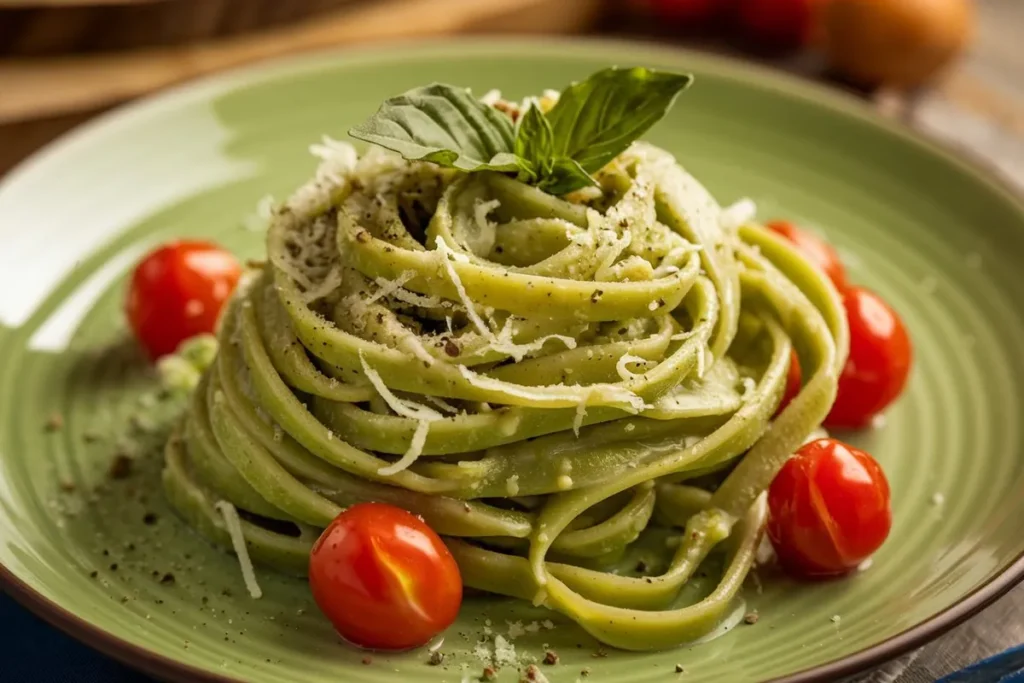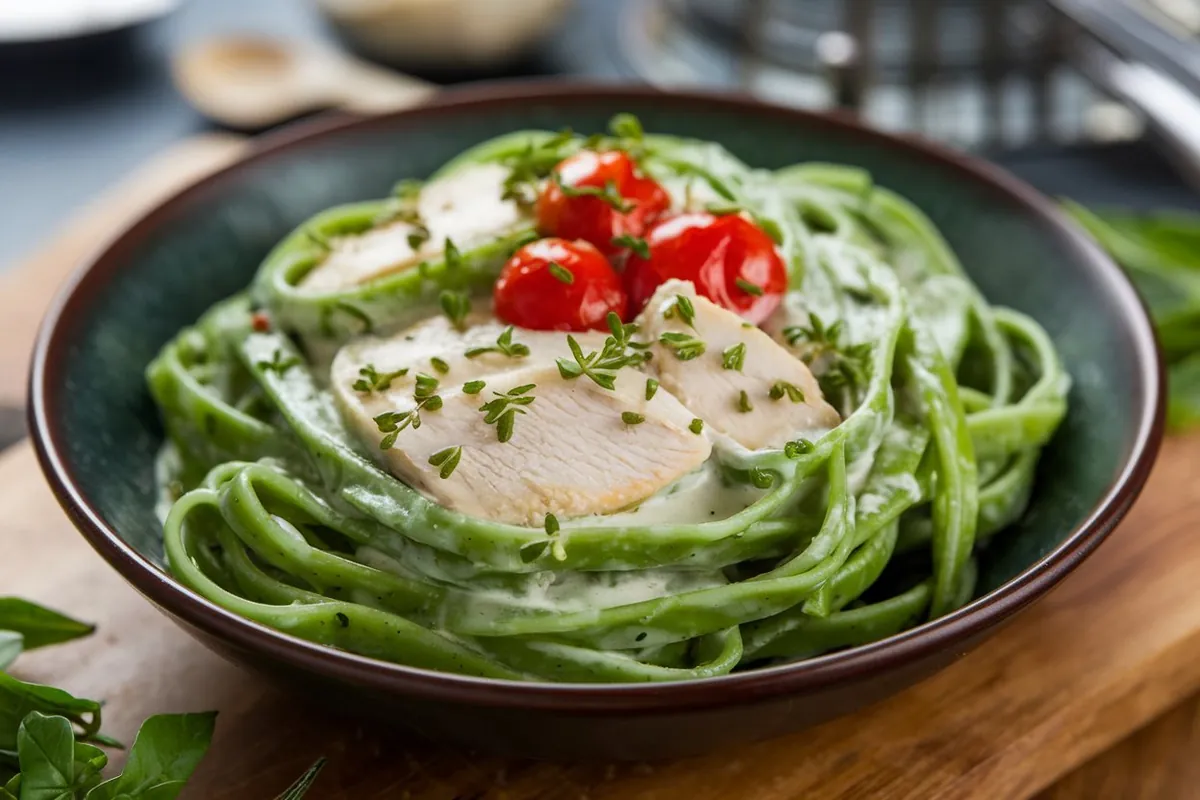Green pasta is not only eye-catching but also a delicious and nutritious twist on traditional pasta. Its vibrant color comes from the addition of leafy greens, which offer both flavor and health benefits. But what is green pasta made from, and how can you make it at home?
In this guide, we’ll explore everything from common ingredients to popular dishes and even dietary alternatives like gluten-free and vegan options. Whether you’re an experienced cook or a beginner, you’ll find plenty of inspiration here.
What Is Green Pasta Made From?
Green pasta gets its vibrant hue from vegetables like spinach, Swiss chard, basil, or even nettle. These greens are typically blended with the dough, adding both color and a subtle, earthy flavor. The most popular choice is spinach, known for its versatility and mild taste. Many Italian dishes incorporate green pasta not just for aesthetics but for its distinct nutritional properties.
- Spinach: The most common ingredient in green pasta, providing vitamins and antioxidants.
- Swiss Chard: Adds a slightly bitter taste and a rich, green color.
- Nettle: A more traditional ingredient, often used in Italian recipes.
- Basil & Arugula: Modern takes on green pasta sometimes include these for a fresh, peppery flavor.
To achieve a vibrant green color, the vegetables are blanched or steamed before being pureed and mixed into the dough. For a detailed recipe on how to make this at home, you can follow our easy steps to make green spaghetti. By adding leafy greens, you’re not only improving the visual appeal but also infusing the pasta with a more complex, earthy flavor profile.
Nutritional Benefits of Green Pasta
Not only does green pasta look great on the plate, but it also packs a nutritional punch. Leafy greens like spinach are loaded with essential vitamins and minerals, such as:
- Vitamin K: Supports bone health.
- Vitamin A: Crucial for vision and immune function.
- Iron: Important for oxygen transport in the blood.
- Folate: Supports cell growth and development.
Green pasta is also a great source of fiber, making it a healthier option compared to regular pasta. The inclusion of vegetables like spinach significantly boosts the pasta’s fiber content, which is beneficial for digestion and can help maintain blood sugar levels. You can read more about its nutritional value in this comprehensive guide on green pasta ingredients.
Comparing Green Pasta to Regular Pasta
Compared to traditional wheat-based pasta, varieties made with vegetables are often lower in calories and higher in fiber, depending on the amount of vegetable content. This makes them appealing for individuals looking to boost their vegetable intake or those aiming for healthier meals without sacrificing flavor. The inclusion of greens in these pasta types provides a significant boost of nutrients, particularly when contrasted with regular pasta, which is mostly carbohydrate-based.
How to Make Green Pasta
Making green pasta at home is straightforward. The process requires just a few ingredients, but it’s important to get the texture right for the best results.
Ingredients:
- 3 large eggs
- 1.4 oz (40g) steamed or boiled spinach (or other greens like basil or Swiss chard)
- 3 cups (14 oz) 00 flour or all-purpose flour
- A pinch of salt
Instructions:
- Prepare the Greens: Steam or boil spinach until tender. Drain and press out as much liquid as possible. If you’re using Swiss chard or basil, follow the same process.
- Blend the Greens: Add the cooked greens and eggs to a food processor. Blend until smooth.
- Mix the Dough: In a large bowl, mix the flour and salt. Add the blended mixture and knead until a dough forms. The dough should be elastic but not too sticky.
- Rest the Dough: Wrap the dough in plastic and let it rest for 30 minutes in the fridge.
- Roll and Cut: Use a pasta machine or rolling pin to flatten the dough, then cut into your desired shape (fettuccine, lasagna sheets, etc.).
- Cook: Bring a pot of salted water to a boil and cook the pasta for 2-3 minutes. Fresh pasta cooks faster than dried pasta.
You can explore more variations by checking out this green spaghetti recipe.
Tips for Perfect Green Pasta
- Use Fresh Greens: For the brightest color, use fresh spinach or greens.
- Don’t Overcook the Pasta: Fresh pasta only needs a couple of minutes to cook.
- Try Different Greens: Experiment with basil, arugula, or even kale for unique flavors.
- Blanch Greens for Bright Color: Blanching greens helps preserve the vibrant green color, making your pasta look as good as it tastes.
Gluten-Free and Vegan Green Pasta Options

If you follow a gluten-free or vegan diet, you can still enjoy green pasta. Here’s how:
Gluten-Free Green Pasta
Substitute regular flour with gluten-free alternatives such as chickpea flour, almond flour, or rice flour. This way, you can enjoy the same vibrant color and rich flavors without the gluten. For more ideas on how to make gluten-free pasta, visit this resource.
Vegan Green Pasta
Traditional green pasta recipes include eggs as a binder, but you can make a vegan version using substitutes like flax seeds or chia seeds. These alternatives can create a dough that is both soft and pliable, without any animal products. These seeds mimic the texture and consistency of eggs, making them excellent binders in dough preparation.
Why Go Vegan or Gluten-Free?
Many people opt for gluten-free and vegan versions of pasta due to dietary restrictions or preferences. Green pasta is a fantastic base for accommodating these variations, as the core ingredient—leafy greens—is naturally plant-based and nutritious.
Popular Dishes Featuring Green Pasta
Green pasta is incredibly versatile and can be used in a wide range of dishes. Here are some favorites:
Green Fettuccine with Alfredo Sauce
Creamy Alfredo sauce is a perfect complement to the earthy flavors of green fettuccine. The creaminess balances out the subtle taste of spinach or Swiss chard, providing a satisfying meal that’s also visually stunning.
Spinach Ravioli
Spinach ravioli is a crowd favorite, often filled with ricotta cheese or butternut squash and served with a simple butter and sage sauce. The green pasta adds a unique element to this classic dish, making it perfect for dinner parties or family meals.
Lasagna with Green Pasta Sheets
Incorporating these vibrant sheets into your lasagna not only adds a pop of color but also boosts its nutritional value. Imagine layers of rich tomato sauce, creamy béchamel, and tender vegetable-infused pasta baked to perfection.
Sauces That Pair Well with Green Pasta

When choosing sauces for your green pasta, lighter options tend to work best, complementing the natural flavors of the greens without overpowering them. Here are a few excellent choices:
Pesto
Pesto is a classic pairing for green pasta. Whether made from basil, arugula, or even spinach, pesto adds a fresh, herbal flavor that highlights the green pasta’s earthiness. The nutty richness of pine nuts and Parmesan in basil pesto complements the delicate nature of green pasta beautifully, creating a harmonious and vibrant dish. You can try this basil pesto recipe for a fresh, flavorful option.
Cream-Based Sauces
For a richer option, cream-based sauces like Alfredo allow the pasta to shine through. The creaminess of the sauce coats the pasta in a smooth texture without masking the flavor of the greens. A lighter variation, such as a lemon cream sauce, adds brightness to the dish, making it feel fresh and balanced. This pairing is particularly good for spinach or basil-based pasta.
Tomato-Based Sauces
Tomato-based sauces provide a nice contrast to the earthy tones of green pasta. A simple marinara or a tomato basil sauce enhances the subtle sweetness of the greens, while the acidity of the tomatoes adds depth. The combination of fresh herbs and ripe tomatoes in marinara complements the delicate flavor of the greens, making it a go-to choice for many pasta dishes.
Frequently Asked Questions (FAQs)
Is vegetable-based pasta healthier than regular pasta?
Yes, this type of pasta offers additional nutrients from the vegetables used, such as vitamins A, K, and fiber, making it a healthier option compared to traditional pasta.
Can green pasta be made gluten-free?
Absolutely! You can substitute the flour with gluten-free options like chickpea or rice flour. Learn more about gluten-free green pasta options.
What is the best sauce for this pasta?
Light sauces such as Alfredo, pesto, or tomato-based options work best to complement the subtle flavors without overwhelming them.
How long does it last in the fridge?
Homemade versions can last up to 2-3 days when stored in an airtight container in the fridge. You can also freeze it for longer storage.
Conclusion
This vibrant and nutritious pasta is not only a flavorful and healthy option but also a visually stunning alternative to traditional dishes. By incorporating nutrient-rich ingredients like spinach, basil, or nettle, it offers a unique way to boost your daily intake of vegetables while enjoying a delicious meal. Whether you’re a home cook or a pasta enthusiast, you can easily make it at home and experiment with various sauces to create a dish that truly stands out.
This type of pasta is particularly versatile, making it an excellent choice for those who are health-conscious or follow specific dietary preferences, including gluten-free or vegan lifestyles. By substituting traditional ingredients like flour or eggs, this vegetable-based pasta can be adapted to meet dietary restrictions while still delivering on taste and texture. Whether you’re looking to elevate a simple meal or impress guests, this pasta is a creative and nutritious option that offers endless possibilities.
For more great pasta recipes and ingredient guides, visit Avery Recipes, where you’ll find everything you need to take your culinary creations to the next level.
